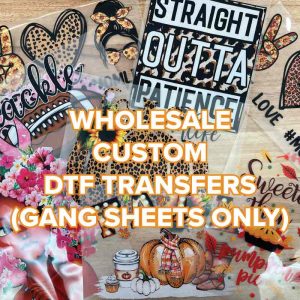What Can DTF Transfers Be Used On?
DTF Transfers Be Used On
Often used for printing on t-shirts, dtf is a transfer printing method that allows you to create vibrant full-color designs and apply them to a wide variety of fabrics or other materials. The process involves using a digital printer to print your design onto a film, which is then backed with adhesive powder and cured in a dryer before being applied to the fabric or other item with a heat press. Although there is a bit of a learning curve to this decorating technique, many decorators say it can save them time and money, especially for small orders or one-off orders.
With a range of colours available, DTF is able to reproduce complex images with high vibrancy and detail. This makes it ideal for creating branded t-shirts or customising other apparel with a logo, slogan or other text. It can also be used to print on a variety of different fabrics, including 50/50 blends and treated or water-resistant garments. Additionally, DTF eliminates the need to pretreat the garment and the weeding process that comes with screen-printed transfers, which can significantly reduce the overall production time of a project.
The DTF printing process is also a great choice for personalising plastics such as phone and tablet cases, bags or other promotional items. The process can be particularly effective on textured materials such as aluminium, and the thin transfer can also allow the colour of the material to shine through. However, it is important to perform test prints on all substrates before applying the printing to ensure compatibility and adhesion.

What Can DTF Transfers Be Used On?
For businesses looking to take their decorating capabilities to the next level, dtf transfers can be used on non-fabrics too. These include hats, bags, cushion covers and table cloths. Alternatively, they can be used as an alternative to textile labels on clothing products to display care instructions, material composition and sizing. This can help avoid the cost and hassle of sewing on traditional textile labels, while ensuring that all of your products are properly labeled for maximum customer satisfaction.
Another hallmark of DTF Transfers is their cost-effectiveness. Traditional financial institutions are notorious for imposing hefty fees and hidden charges on international transfers, diminishing the value of the transferred amount. In contrast, DTF Transfers typically offer competitive exchange rates and transparent fee structures, ensuring that the sender and recipient retain the maximum value of the transaction. This affordability factor makes DTF Transfers an attractive option for individuals and businesses alike, especially those engaged in frequent cross-border transactions.
In addition to printing on a variety of materials, DTF is also a great option for decorating other objects, such as glass and metal. It is worth noting, though, that the transfer is less durable on these types of items. Before you start printing with DTF, it is recommended to learn about the process through videos and tutorials. You can also visit another shop that uses the process to observe how it is done from beginning to end. This will help you gain a deeper understanding of the process and how to use it in your own business. Once you have mastered the basics of DTF, you can start applying it to your own projects and become a DTF ninja in no time. To get started, find a supplier that offers dtf transfer film, powder and adhesive. Then, follow the manufacturer’s instructions to set up your equipment and print the design on the film.